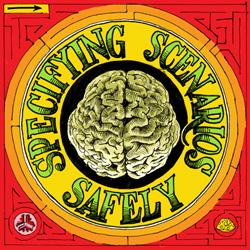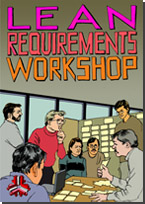Specifying Scenarios Safely teaches you how to use Behavior-Driven Development
to improve your software development capability: You will see how collaboration is the keystone practice that
helps you
explore and document the most important scenarios for your system.
You will learn to write scenarios using the Gherkin language, which will make it easier for your development
team to automate scenarios to create a safety net of regression tests.
Finally, you will explore some key patterns that help you write scenarios effectively.
Highlights

Safe BDD: Become behavior-driven by learning to compose safe scenarios.
Learn more...
Behavior-Driven Development with Safe Scenarios
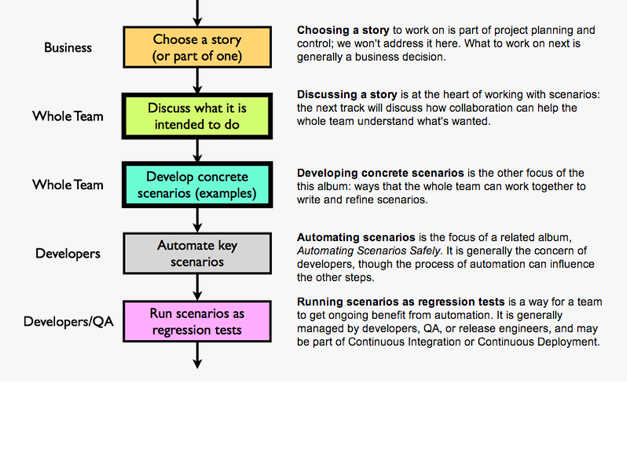
Practice Behavior-Driven Development safely by learning how to collaboratively specify and automate scenarios.
Learn how to compose scenarios using Gherkin, the popular BDD syntax.

Expert Videos: Learn tools & techniques by watching short videos from industry experts.
Learn more...
Watch Short, Engaging Videos by Experts
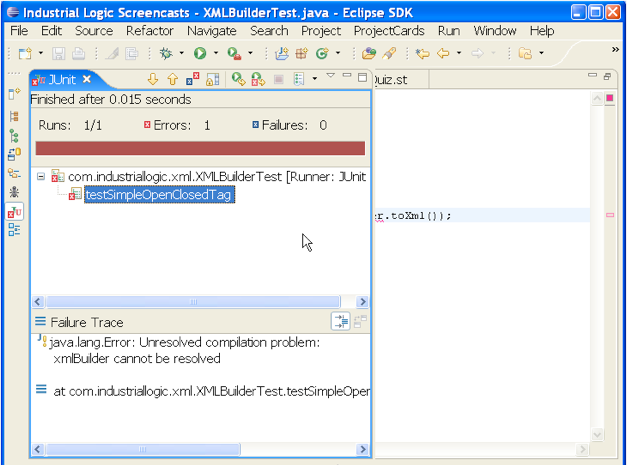
Watch our experts efficiently explain models, demonstrate tools and solve exercises.
Like a good pop song, every video we make holds your attention and gets you into a better development rhythm.

Integrated Forums: Ask questions, get expert replies and read fascinating discussions.
Learn more...
Engage in a Global Forum
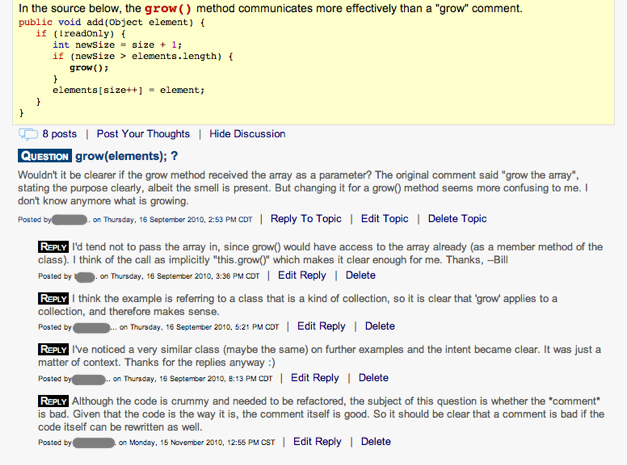
No other eLearning system on the planet matches our discussion forums, woven throughout every album.
Ask questions, get expert replies, read and weigh in on fascinating discussion threads from a global audience.
Includes
- 2-4 hours of content
- 76 pages
- Scenario Writing Strategies & Tactics
- 5 Interactive quizzes
- 2 Exercises
- 3 Videos
Contents
|
Scenario Collaboration
|
11
|
|
Software As An Information System
|
12
|
|
Focus on Learning to Improve Product Development Results
|
13
|
|
Traditional Software Development
|
14
|
|
Beware of Duplication and Inconsistencies
|
15
|
|
Collaborating Around Scenarios
|
16
|
|
Leveraging Examples as Tests
← Click to Preview
|
17
|
|
Improving Our Software Development Capability
|
18
|
|
Common Pitfalls
|
19
|
|
Succeeding Together
|
20
|
|
Quiz: When To Collaborate
|
21
|
|
Specifying by Example
|
23
|
|
Event and Response
|
24
|
|
System Boundary
|
25
|
|
Outside the Boundary
|
26
|
|
Multiple Touchpoints
|
27
|
|
Problem Space and Solution Space
|
28
|
|
A Simple Example
|
29
|
|
A Series of Tests
|
30
|
|
Tables Simplify Repetitive Scenarios
← Click to Preview
|
31
|
|
Why Use A Special Scenario-Writing Syntax?
|
32
|
|
Browseable Formatting, Starting with Features
|
42
|
|
Complex Setup with Inline Tables
|
43
|
|
Scenario Setup Repetition
|
44
|
|
Sharing Scenario Setup With A Background
|
45
|
|
Dealing With Repetition: Scenario Outlines
|
46
|
|
Scenario Outlines or Inline Tables?
|
47
|
|
The Magic of Tags
|
48
|
|
Gherkin Syntax Quiz
|
49
|
|
Specification Patterns
|
62
|
|
Essence Not Implementation
|
63
|
|
Don't Dial Every Number
← Click to Preview
|
64
|
|
Include Only Relevant Details
|
65
|
|
Interesting First
|
66
|
|
Simple To Complex
|
67
|
|
Expressive Scenarios
|
68
|
|
Minimal Setup, Minimal Evidence
|
69
|
|
Standard Setup
|
70
|
|
Staying Relevant
|
72
|
|
Guides and Guards
|
73
|
|
Avoid False Positives
|
74
|
Highlights

Safe BDD: Become behavior-driven by learning to compose safe scenarios.
Learn more...
Behavior-Driven Development with Safe Scenarios

Practice Behavior-Driven Development safely by learning how to collaboratively specify and automate scenarios.
Learn how to compose scenarios using Gherkin, the popular BDD syntax.

Expert Videos: Learn tools & techniques by watching short videos from industry experts.
Learn more...
Watch Short, Engaging Videos by Experts

Watch our experts efficiently explain models, demonstrate tools and solve exercises.
Like a good pop song, every video we make holds your attention and gets you into a better development rhythm.

Integrated Forums: Ask questions, get expert replies and read fascinating discussions.
Learn more...
Engage in a Global Forum

No other eLearning system on the planet matches our discussion forums, woven throughout every album.
Ask questions, get expert replies, read and weigh in on fascinating discussion threads from a global audience.
Includes
- 2-4 hours of content
- 76 pages
- Scenario Writing Strategies & Tactics
- 5 Interactive quizzes
- 2 Exercises
- 3 Videos
Contents
|
Scenario Collaboration
|
11
|
|
Software As An Information System
|
12
|
|
Focus on Learning to Improve Product Development Results
|
13
|
|
Traditional Software Development
|
14
|
|
Beware of Duplication and Inconsistencies
|
15
|
|
Collaborating Around Scenarios
|
16
|
|
Leveraging Examples as Tests
← Click to Preview
|
17
|
|
Improving Our Software Development Capability
|
18
|
|
Common Pitfalls
|
19
|
|
Succeeding Together
|
20
|
|
Quiz: When To Collaborate
|
21
|
|
Specifying by Example
|
23
|
|
Event and Response
|
24
|
|
System Boundary
|
25
|
|
Outside the Boundary
|
26
|
|
Multiple Touchpoints
|
27
|
|
Problem Space and Solution Space
|
28
|
|
A Simple Example
|
29
|
|
A Series of Tests
|
30
|
|
Tables Simplify Repetitive Scenarios
← Click to Preview
|
31
|
|
Why Use A Special Scenario-Writing Syntax?
|
32
|
|
Browseable Formatting, Starting with Features
|
42
|
|
Complex Setup with Inline Tables
|
43
|
|
Scenario Setup Repetition
|
44
|
|
Sharing Scenario Setup With A Background
|
45
|
|
Dealing With Repetition: Scenario Outlines
|
46
|
|
Scenario Outlines or Inline Tables?
|
47
|
|
The Magic of Tags
|
48
|
|
Gherkin Syntax Quiz
|
49
|
|
Specification Patterns
|
62
|
|
Essence Not Implementation
|
63
|
|
Don't Dial Every Number
← Click to Preview
|
64
|
|
Include Only Relevant Details
|
65
|
|
Interesting First
|
66
|
|
Simple To Complex
|
67
|
|
Expressive Scenarios
|
68
|
|
Minimal Setup, Minimal Evidence
|
69
|
|
Standard Setup
|
70
|
|
Staying Relevant
|
72
|
|
Guides and Guards
|
73
|
|
Avoid False Positives
|
74
|
Volume Licensing
Volume Licensing
In today's competitive environment, Industrial Logic aims to meet the needs of business customers not only by delivering world-class eLearning but also by providing a high degree of flexibility. Whether your organization is a startup, small- or medium-size business, or a large global enterprise, you benefit as a corporate customer from significant discounts.
Benefits
-
Volume pricing discounts. It's simple: the more you purchase, the more you save.
-
Custom catalogs. Define your custom catalog of albums and/or box sets that your staff can subscribe to.
-
One-on-one support. You get a dedicated Account Manager; choose the optimal program to meet your organization's specific needs.
-
Timely support. Expert coaches are available to answer your challenging questions within 1 to 2 business days. To foster a community of enthusiastic eLearners, we welcome and encourage user feedback.
-
Streamlined procurement process. With a single purchasing contract, you can avoid departmental budget constraints, differing purchasing procedures, and other administrative hurdles.
-
Flexible payment options. We offer flexible payment for qualified customers.
-
Unlimited lifetime license. Your students' licenses will not expire, providing continuous access to an effective, ever-improving learning tool.
Industrial Logic will tailor our volume licensing agreement to meet the needs of your specific organization, whether you consolidate your organization's purchases into one comprehensive transaction or spread your purchases out over a scheduled period of time. The more you order, the greater your savings.
To speak to a dedicated Account Manager today, please contact us.






